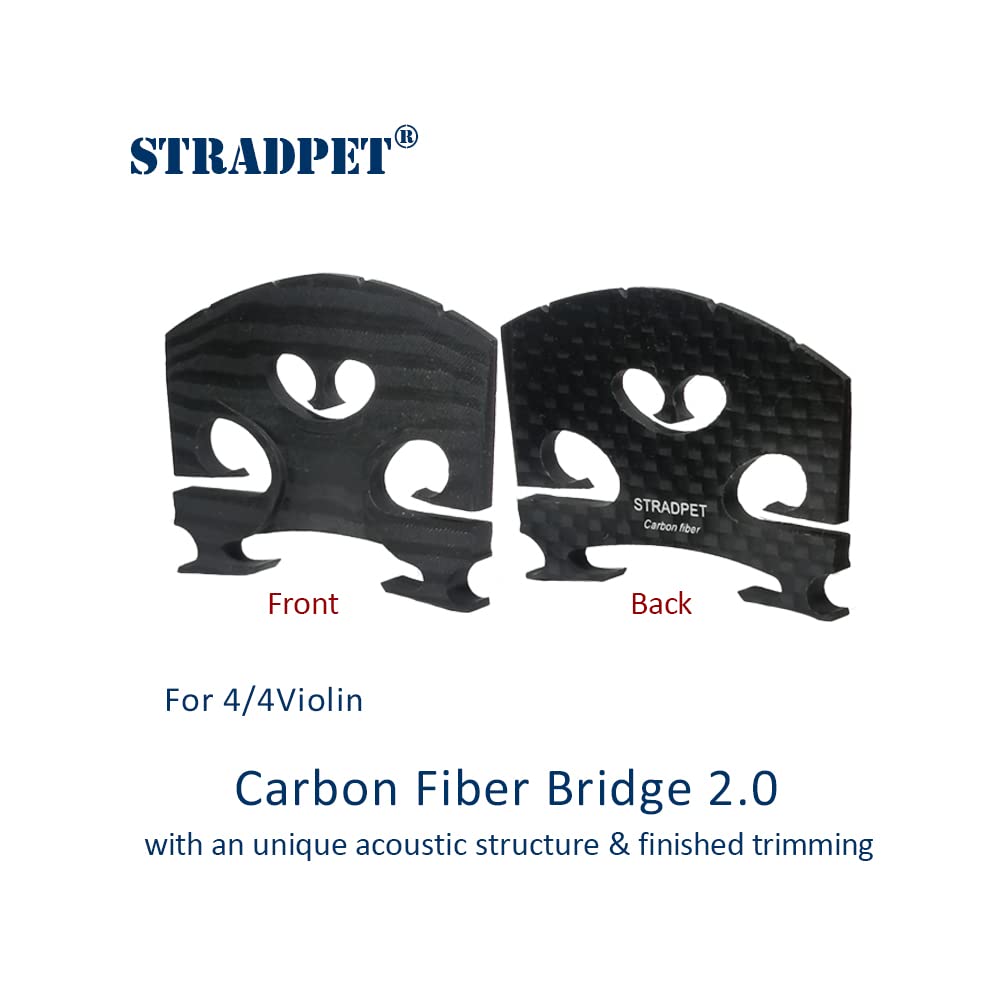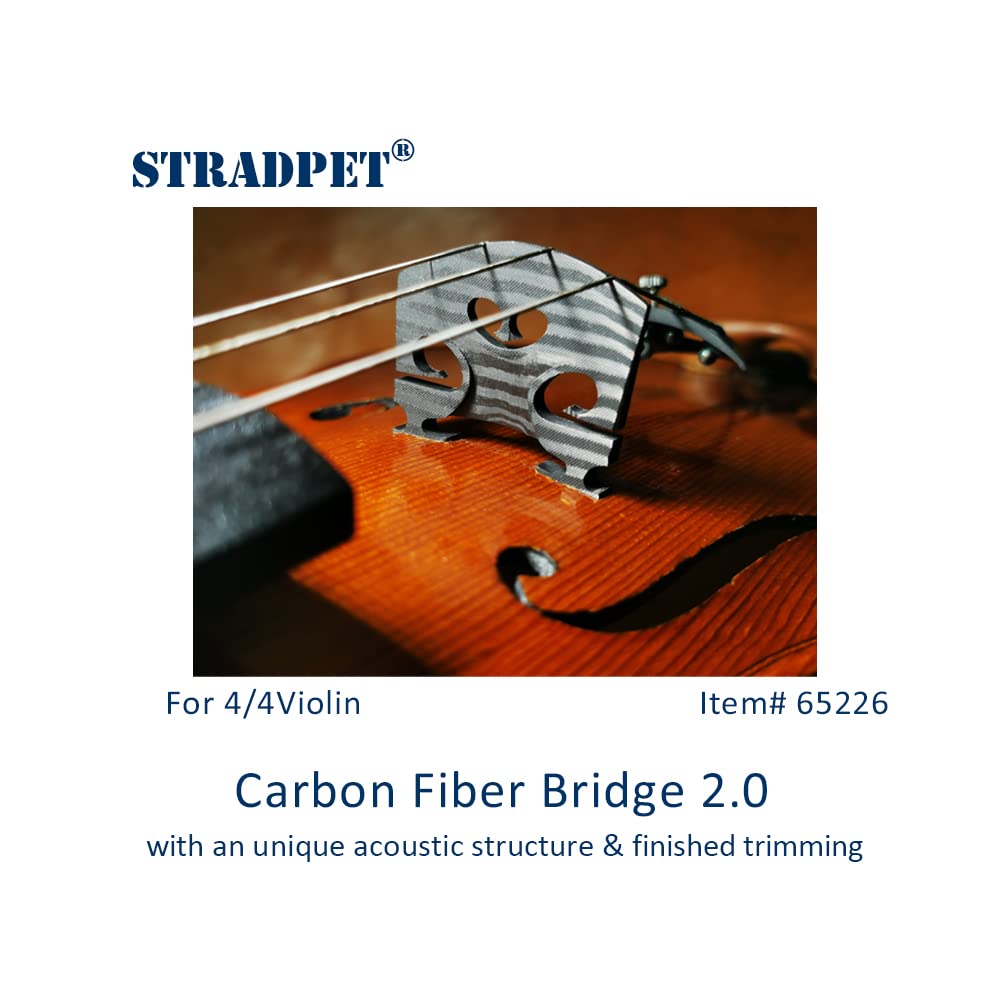






🎶 Elevate Your Sound with STRADPET's Carbon Fiber Bridge 2.0!
Carbon Fiber Bridge 2.0 with an unique acoustic structure & finished trimming for 4/4 violin
A**R
Stable, Clean Sound on 100+ Year Old Fiddle!
STRADPET arrived when expected and well packaged. One of my fiddles, "Ken", is German made, somewhere between 1890 and 1910 based on its markings and label. A local luthier said it's a professional quality instrument. However, even though a 100+ year maple bridge was custom made for it, it developed a loud harsh sound. After reading the reviews on Amazon, I decided to try STRADPET on it. (I'm a Materials Scientist). I'm VERY happy with the results! For me, installing STRADPET was easy, and it fits the instrument well, string height is fine, and with no adjustment needed to the feet. It really evened out "Ken's" tone across all strings, and its a clear pleasing sound. I live in an area where the weather changes frequently, and STRADPET seems to be VERY stable. Prior to this, I had tried other strings on this instrument and two different wire mutes, none of which really solved the problem. I plan to purchase another for another one of my older harsh fiddles!
H**T
Cut perfectly
It took some time to ship but this bridge just fixed all the issues I had with my old bridge. The A string before changing bridges was cut too low and I would play the A and E string together (unintentionally).The tone is more even to my ear and the entire violin (a fixer-upper) resonates better than with the wood bridge this replaced. I like the pre-carved string slots and for that reason, not worrying about using a string protector on the E string. Not all string sets come with string protectors.It was worth the wait, my violin is playing better and sounds better when amplified.
J**.
Softer sound but grittier yet cleaner tone
Looks dope and sounds good just not as loud. It gets rid of the squeaky sound a violin sometimes has on the higher strings and gives it a more fuller sound. 8/10 (It frailed one of my strings on installation aswell as the top plate of my violin but its wtv)
R**N
Does improve the sound
I have a recently tried out the STRADPET Carbon Fiber Bridge 2.0 on my inexpensive violin, and I have to say, I'm pretty impressed! The bridge is designed to enhance the sound of cheaper violins, which often have mass-produced, thick bridges that don't allow for the fullest sound possible. The STRADPET bridge, on the other hand, is incredibly thin and lightweight yet still sturdy enough to support the strings.One of the things I appreciated most about this bridge is that it doesn't choke off any frequencies. The tone of my violin was noticeably fuller and more even with the STRADPET bridge in place. Plus, it looks pretty cool, which is always a bonus.Of course, fitting a new bridge to a violin can be a bit tricky. If you're not experienced with this kind of thing, you'll want to take it to a luthier to have it done properly. Even if you are experienced, you may need to glue in some maple spacers to get the fit just right. But once you've got it properly fitted, the difference in sound is worth the effort.At $20, this is a pretty affordable upgrade for anyone looking to get a little more out of their cheap violin. I'd recommend it to anyone who knows what they're doing or is willing to learn. Overall, I think this is a great product for anyone looking to improve the sound of their violin without breaking the bank.
A**Z
Muffles the sound of your violin
My violin was loud and when I installed this bridge it was muffled like if it had a mute on :( big sad cause it looked cool :(
S**0
An excellent violin bridge for those willing to use non-traditional materials
I purchased this bridge to replace a bad bridge on a cheap violin purchased at a garage sale. I was very surprised at how well this worked, and how easy it was to install.My biggest concern was that I am not used to shaping wood bridges. Bridge blanks come larger than needed. The base has to be sanded to match the violin contour. They must be sanded to the correct height for string clearance over the fretboard and the upper curve is usually customized to the player's preference. Then they have to be slotted for proper string location, and also strategically thinned to optimize sound quality.Sandpaper is cheap, but I do not have the appropriate files to cut the string notches. Also, most inexpensive violins use a tiny piece of tubing over the high E string to prevent the string from cutting into the finished bridge, and I do not have any of this tubing.Only one side (the heel side) of this bridge shows the carbon fiber weave. The other side (facing the scroll) is a matte black surface, likely from the manufacturer sanding it to the correct thickness.This bridge comes already shaped to a good thickness and upper contour for playing, and pre-slotted for the strings. Sanding the base to fit the violin contour and for preferred string height is possible, but in my case was not at all necessary as both feet rested firmly on the wood when inserted under the loosened strings.Installing this was really quite simple, and required no sanding or filing at all. Because carbon fiber is so strong, I had no concerns at all about installing the high E string without tubing to protect the bridge.The sound while using this bridge is clearer than the old wood bridge, and I found a noticeable improvement in sustain, especially for the lower strings. The overall volume of sound has increased.I bought a garage sale violin to experiment with, and I'm so pleased with the result that I will be buying this bridge for my primary violin as well, as well as seeking out other carbon fiber bridges for my other stringed instruments.
A**1
Hmmm...it only worked for one of my violins.
Initially, I hated this bridge because it wouldn't fit any of my most used violins (generally too high on both the 'G' and 'E' string sides). I didn't give up though and it actually fit an old Colin-Mezin very well. I hadn't played on the CM in a while because I hated the overall quality of the sound. After installing the CF Bridge, I was pleasantly surprised at how much better it sounded. It eliminated the super nasally sound and mellowed out the bright 'E' string enough that I feel the violin is now very playable. Be aware that the bridge is fixed and unalterable so your instrument's original bridge needs to be "matched" before trying this very inflexible material. As stated by others, be very careful with the feet as they are thin, sharp and will damage the surface of your violin if you try to slide it around for adjustment.
青**主
初心者向けではないが使える
カーボン製なので,駒の足下を削って調節できないし,弦の高さも調節できない.なので,自分の持っているバイオリンの表板の湾曲率にあっていないと使えない.と,普通なら思うでしょう.でも,工夫次第でちゃんと使えます.駒の足下がバイオリンの表板の湾曲率に合っていないなら,薄い目のシリコンシートを適当な大きさに切って挟むと良いです.弦の高さを調節したいなら,弦にシリコンチューブを巻けば良いです.木製の駒に比べて音が云々と言うのは,ほとんどの場合,駒とバイオリンの接触率の問題でしょう.ちゃんと接触している限りなら,普通以上に鳴ります.
た**ん
普通
よくわからない。普通
A**ー
キーホルダーにするしかない
駒の足が加工できないのでほとんどのバイオリンには装着できないでしょう。ちなみに音はスッカスカになりました。
Trustpilot
2 weeks ago
3 weeks ago